Survey Of Impact Positions Of PGA Tour Players Target Line & Front View
- by Kelvin Miyahira
Why study elite swings? If money were not a concern would you buy a Bentley Phantom ($450,000) or a VW Bug ($20,000)? Would you want your kids to have straight A’s in school or C’s? Would you want your child to go to Harvard or the local community college? Would you want to eat that prime aged filet mignon or the chuck steak from the supermarket? I’m sure you get my point. Everything works. The VW Beetle will get you there just the same as the Bentley but not with the same style and comfort. The chuck steak will deliver the same nutritional value as the filet but not melt in your mouth. So it is with golf swings. Why copy what Mr. Average is doing on tour? Sure, he may have a few wins but is his/her swing elite? Is it something you want to copy and learn from? And if you copy some of Mr. Average PGA Tour player’s swing flaws because you don’t know the difference between elite moves and less than optimal moves, does this not debilitate you? Or if you learn a swing method that relies on tour players’ natural instincts to fill in the blanks (correct moves) while promoting movements that are the exact opposite, how will you ever improve at this game?
Typically, when one thinks of a PGA tour pro, we think they are so awesome and hit the ball so well. Well they do. But how about when they are stack up against each other? They are all fantastic athletes but why do some hit it farther than others? Why are the short, straight hitters not able to hit it longer? Since Bubba Watson hit the par 5’s on the back nine at Augusta with short irons and won, isn’t this like Tiger in 1997 doing the same (although this is before they lengthened the course)? Sure, Bubba had to win in a playoff vs. demolishing the field like Tiger did. But the bottom line is Bubba’s win might be another defining moment in golf where everyone on tour needs to take notice. Distance matters once again just as everyone knew it when Tiger dominated in the 1999-2001 era.
In my world, short and straight hitting does not equal great ball striking regardless of how pure one strikes it. Forgive me Moe Norman, but I’m sure Bubba could hit his 5 iron as far as your driver AND be as straight. The challenge is to hit it long and straight. The legends, Hogan, Snead, Palmer, Nicklaus and young Tiger all figured out how to do this.
It takes more skill and better swing mechanics to be able to hit a ball long and straight vs. short and straight. A player swinging above 120 miles per hour, all things being equal, has to be a lot more precise with his impact zone movements (clubface closure rate must be lower and better release style) vs. players swinging in the low 100 mph range. One degree off line on a 350 yard drive is going to be farther off line than on a 270 yard drive.
With that in mind I thought it would be interesting to do a survey of how the tour players look at impact from the target line view to see how the tour players were doing with some of the movements I have found in only the best. But since it’s hard to determine what’s going on from just that one viewpoint, I had to add in their front view as well so we can put the two images together to get a more three dimensional view of what’s occurring in these golf swings.
This is the key to understanding some cause and effect relationships in the golf swing that I’ll be taking a closer look at in months to come. This study will explain why some are hitting it longer than others, why some are straighter than others, and how the body movements are ultimately affecting their release styles.
Methodology
In order to get the most consistent views, the camera angle had to be reasonably set up. This means the feet looking reasonably close to parallel to the camera lens at address (some are pulling their front foot back before impact). Slight changes in camera angle can show very different looking positions. So if camera angle was too far off, the swings were eliminated from the study. Also, I needed both front and target line view in order to be included in this study. Driver or at the very least fairway woods/hybrids needed (for target line view) to be used in order to see the most dynamic movements the pros would make.
*Note: After the top categories, I’ve just posted a few representative examples in each category and then listed the names of the other players that fit that swing type.
Elite Golf Swings
The truly elite golf swings are defined (by me) by having several key characteristics:
- Lateral bend/lordosis – in other words, spine engine driven vs. arm or leg driven.
- Shoulders rotating on a more vertical plane (tilted at impact) vs. more horizontally (parallel to hips).
- Rib cage (sternum) rotation vs. chest sliding, stalling or covering the ball.


This is a new concept that more clearly distinguishes correct movement from incorrect. By having good lateral bend/lordosis, one can rotate the rib cage/sternum area much more effectively. Pictured above is Brian Gay on the left, Gary Woodland on the right.

By drawing a line on the shoulders and then on the shirt placket, it can help to visualize the sternum position at impact. The more forward it is angled, the more rotation there is. Like the bucking bronco, the rib area in the human body is a hugely powerful source of power that’s overlooked because we’ve been programmed to look at shoulders and hips.- Hips rotating vs. stalling, thrusting or jumping.
- Left leg straightening and hips extending to assist rotation (must be on the chi line) vs. staying bent, jump/stall or sliding/stall.
- Front foot spinning (left leg continues to rotate) vs. flat footed (planted, posted up and inhibiting leg rotation).
- Right arm bent at impact vs. straight – maximizes stability of impact with next trait.
- Right wrist bent (extension) at impact vs. straightening or bowing (flexion).
- Two previous characteristics contribute to the release pattern. Drive/holding vs. flip, flip/rolling, rolling, underflipping, etc.
Legends
 ,
, 
Ben Hogan
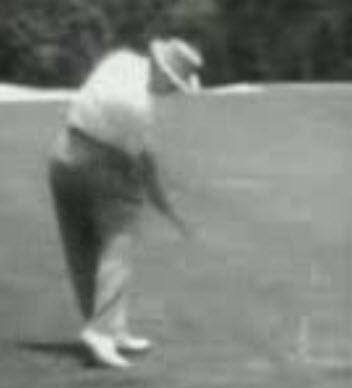 ,
, 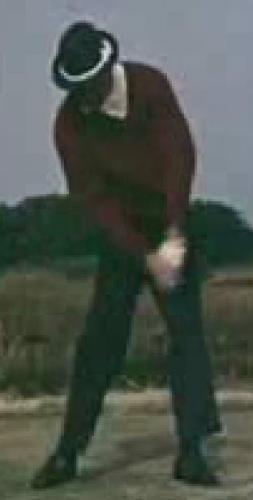
Sam Snead

 ,
,
Arnold Palmer

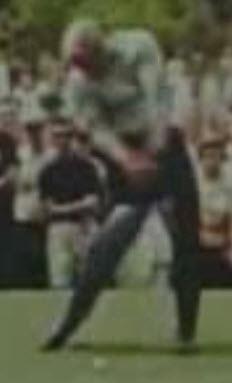
Jack Nicklaus
Jack was great in the early 60’s but by the mid 60’s he started to slide farther and farther left.
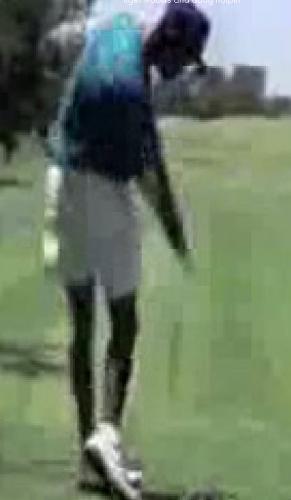
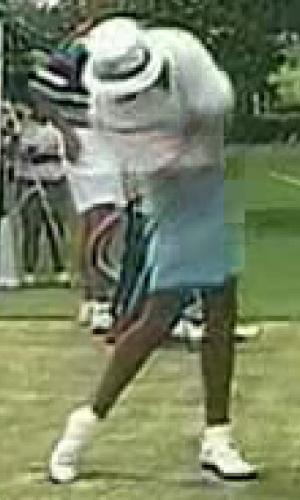
Tiger Woods Early and Mid 1990’s
Gold Medalists
These players have it all.

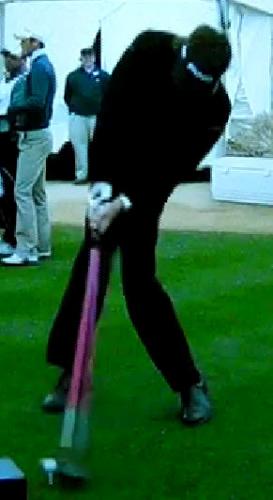
Bubba Watson
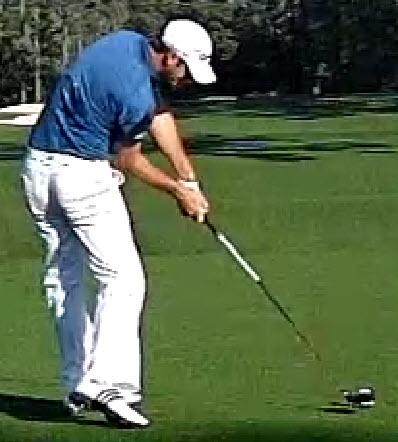
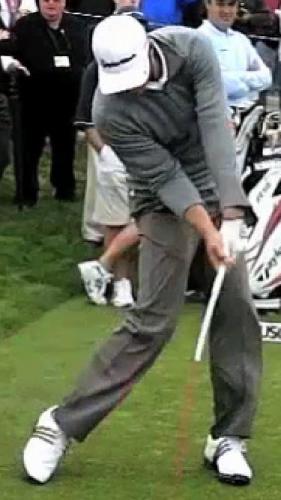
Dustin Johnson

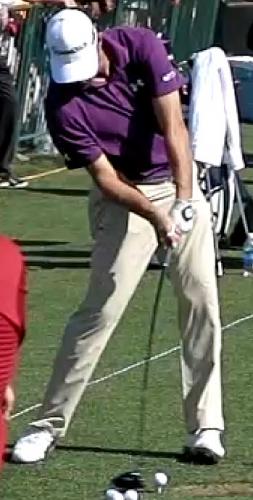
Gary Woodland

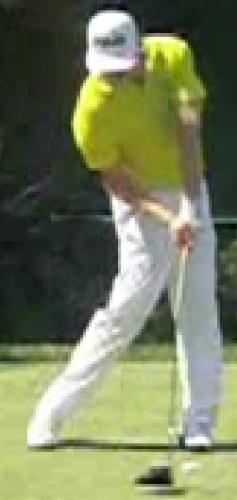
Hunter Mahan
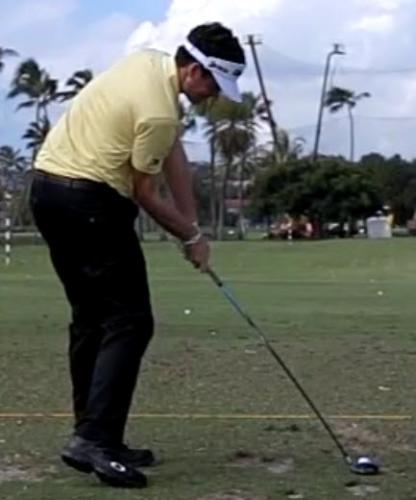
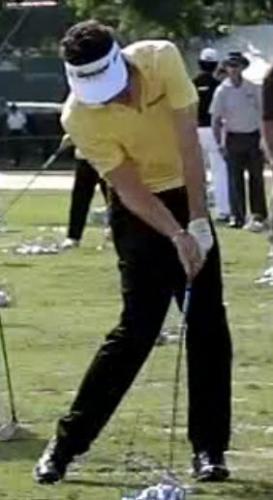
Keegan Bradley
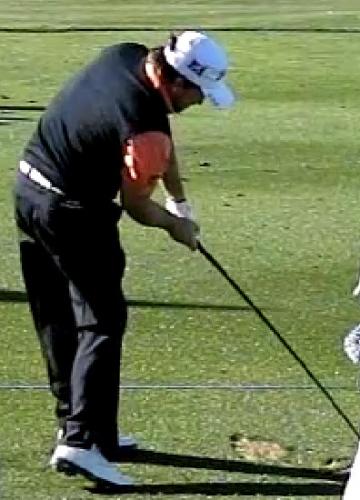
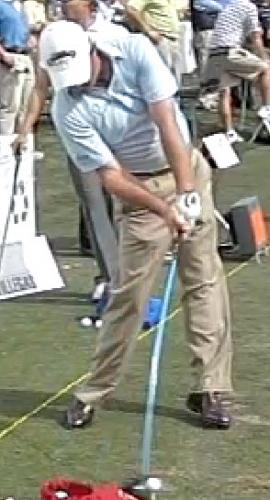
Graeme McDowell
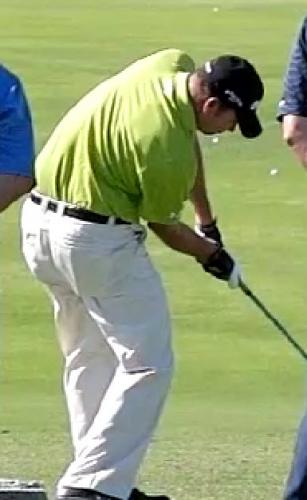

Tommy Gainey
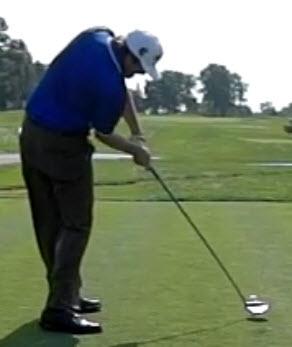
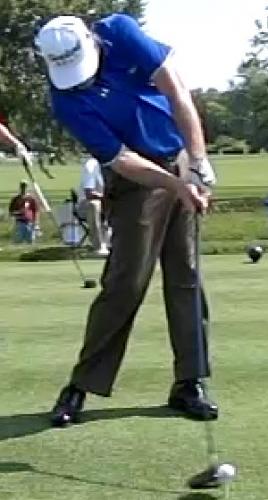
Steve Marino
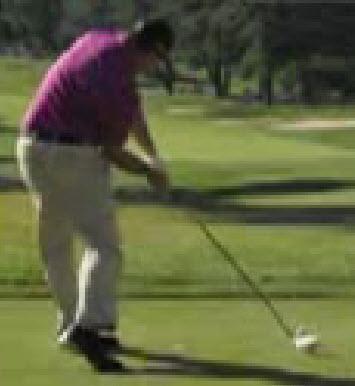
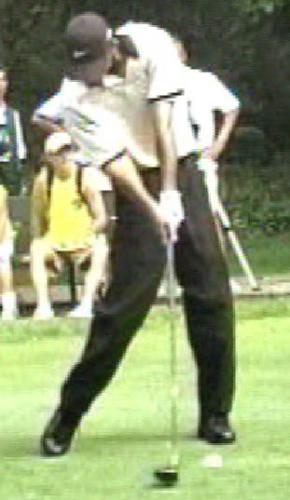
Robert Garrigus
One caveat, in order to win or dominate on tour like Tiger once did, it takes a complete package of great swing, awesome short game, clutch putting, mental toughness and other intangibles. The players in this category are here simply based on pure athleticism, optimal movements and lack of “prettiness.”
Silver Medalists
The silver medalists have all the moves except one or two. They may slide a bit farther left, extend the arms more or extend the top of their spines more. They’re just a notch below but very good.
 ,
, 
Tiger 2002-2004
Not as cleared in hips, shoulders not as tilted and his cervical spine is rising up before impact to make room for his arms straightening.
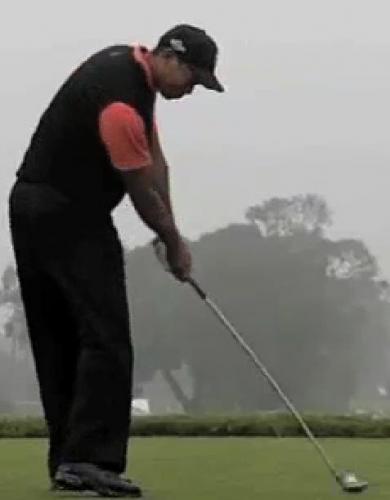

Tiger 2008
Haney had not started to get him shifted so far left just yet but definitely a notch below his prime years.
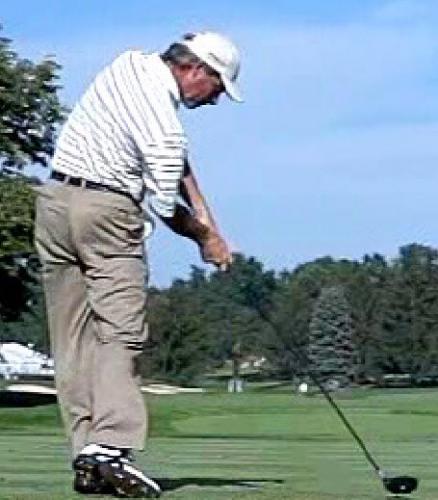

Freddy is a little more flat-footed on the left, slides just a touch too much and this causes more of a “reverse C” position on the follow through that isn’t good for his back.
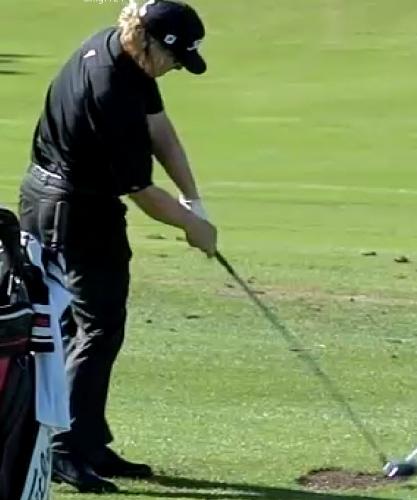
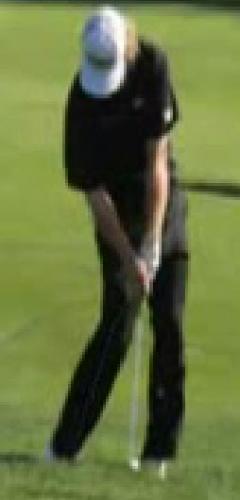
Charley Hoffman
Slightly too far left, little flat footed.

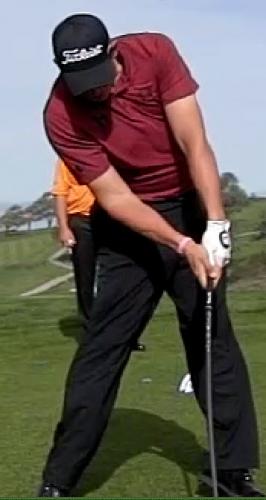
Scott Stallings
Not as much right leg internal rotation (leg extends instead).
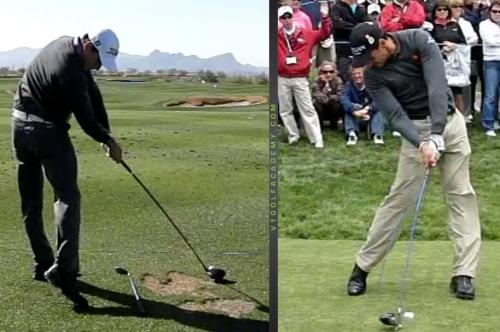
Rafael Cabrera-Bello
Just like Tiger!
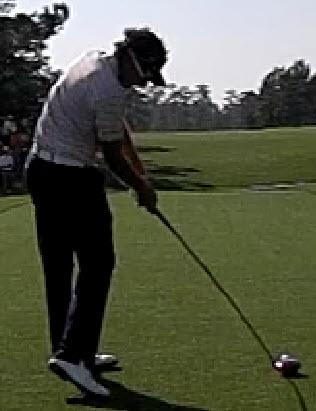
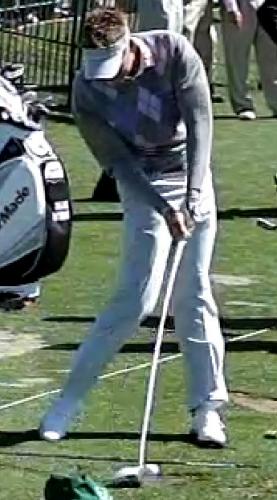
Ian Poulter
Less cleared, less tilted.
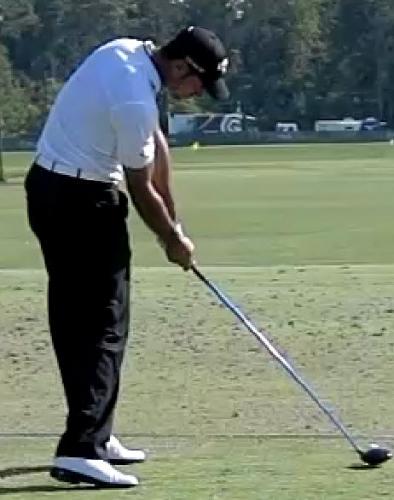

Alvaro Quiros
Less cleared, less tilted, arms straighter.
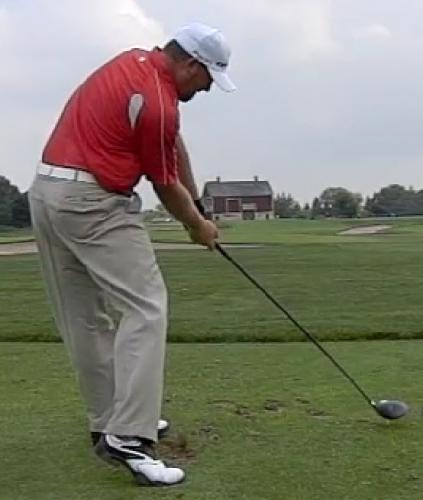
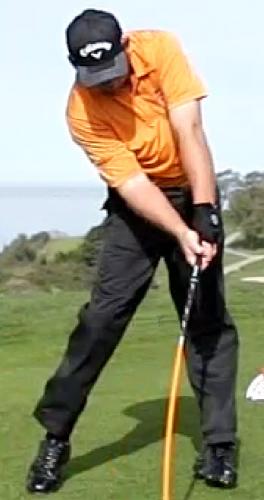
JB Holmes
Arms a little straighter with shoulders slightly released.
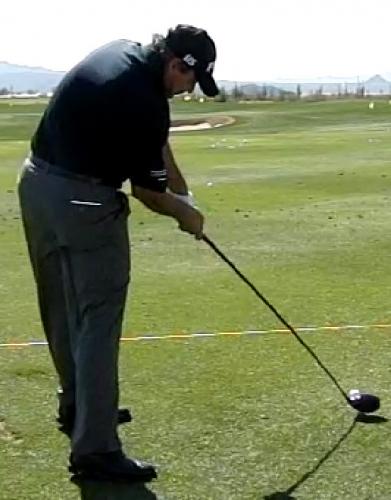
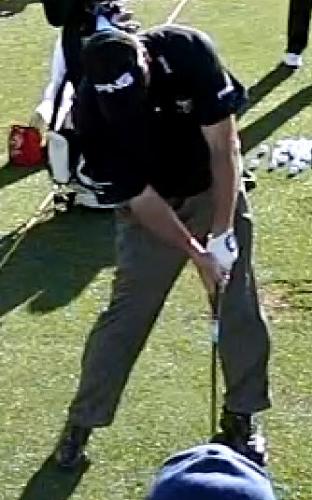
Angel Cabrera
Arm/wrist positions show the compensations for a more open clubface at the top of the backswing. But body positions are great.

Kenny Perry
Bronze Medalists
Good lateral bend minus left leg straightening or sliding too far left
This group is losing 15-20 yards by not using the left leg straightening to create more hip speed at impact. If the player is too far left, the left leg straightening will cause a jump/stall. If they keep the left knee bent and externally rotating, it is better but minus that little extra speed and power.
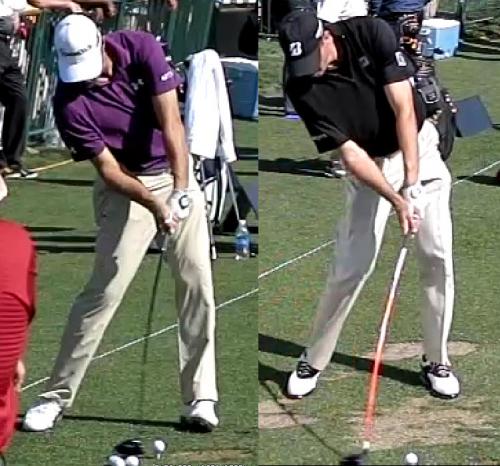
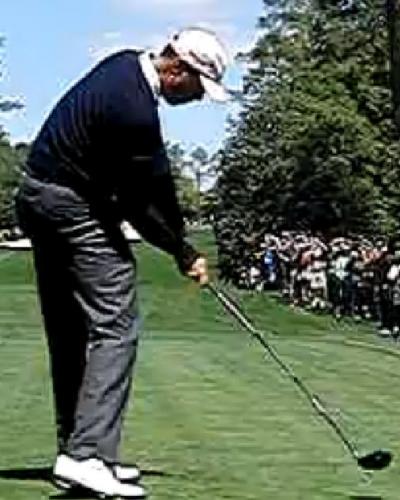
The difference between Woodland and Matt Kuchar is small but important. Woodland has a lot more hip and chest rotation at impact.
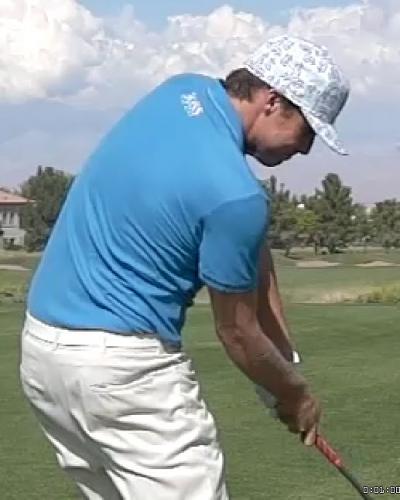

Nick Watney
Sliding while left leg rotates but does not straighten.
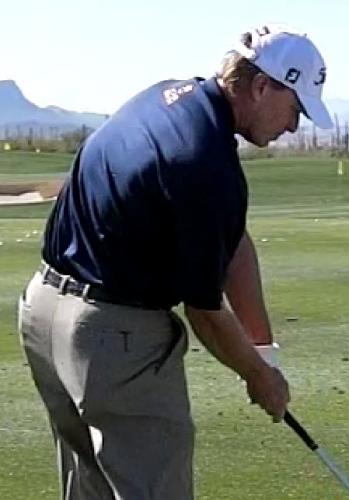
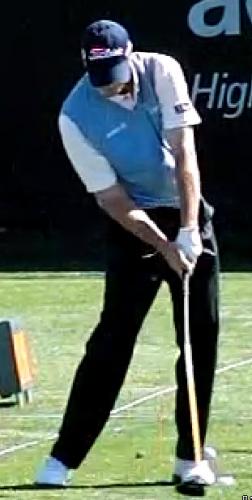
Steve Stricker
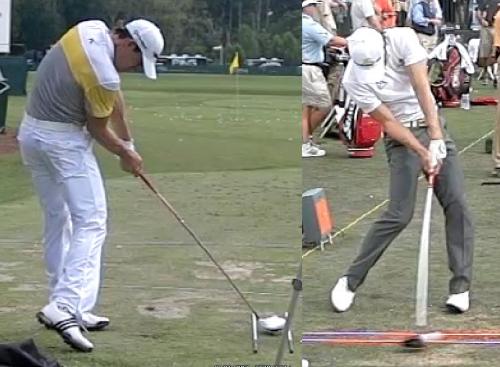
Camilo Villegas
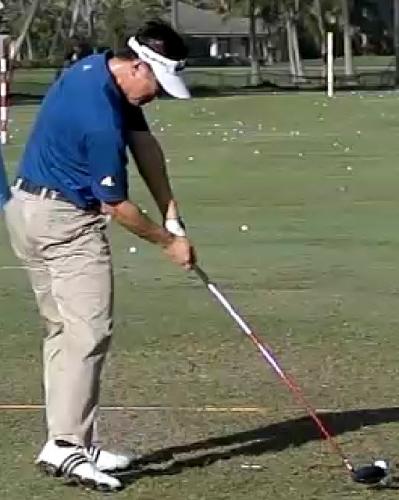
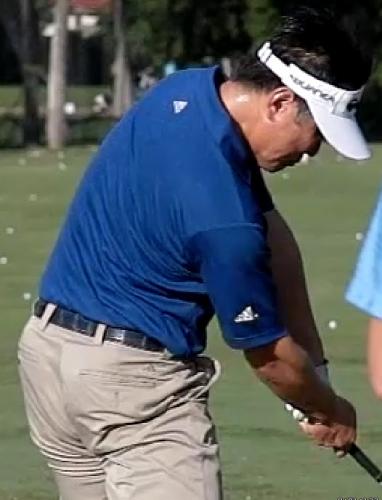
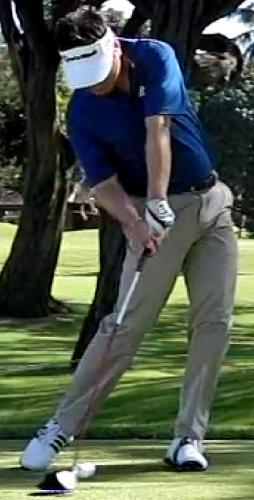
Charlie Wi
Charlie is rotating as well as others in this group despite the excess slide. His left femur continues to rotate, left foot spinning, shoulders tilted, good amount of rib cage rotation and retains lateral bend at impact that’s different (and better) than most stack and tilters.
Other players in this category are:
David Duval
Martin Laird
Tim Clark
Simon Dyson
Josh Teater
Rory Sabbatini
Stephen Ames
Ryo Ishikawa
Thongchai Jaidee
Brendan De Jonge
William McGirt
Jason Dufner
Heath Slocum
Henrik Stenson
Trevor Immelman
Ben Crane
David Toms
Padraig Harrington
Danny Lee
Boo Weekley
Steve Flesch
Ryan Palmer
Boo Weekley
Matthew Goggin
Davis Love III
Eduardo Molinari
Bill Haas
Honorable Mention
Good LB but slight jump/stall
This group has all the right moves but just a little excess slide and this causes a bit of a jump/stall due to the left leg being too vertical while extending. In this way, the left leg cannot be used to create hip rotation and instead causes a jump. These players “lose their spine angle” just a bit but in reality it is loss of lower body rotation.

At the very least the upper spine extends or there is a slight thrust toward the ball with the hips.
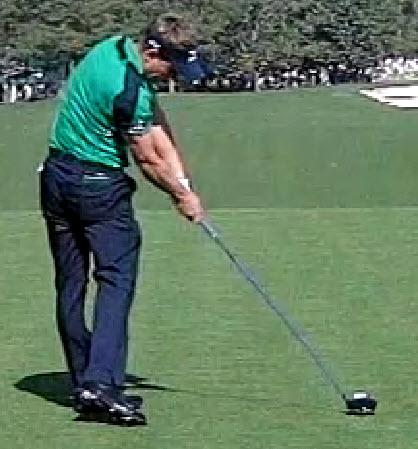

Luke Donald
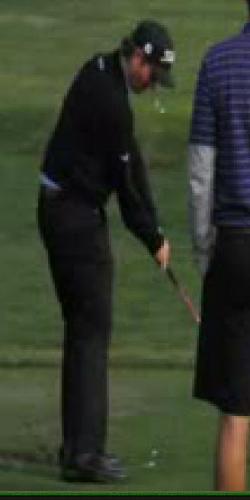

Webb Simpson
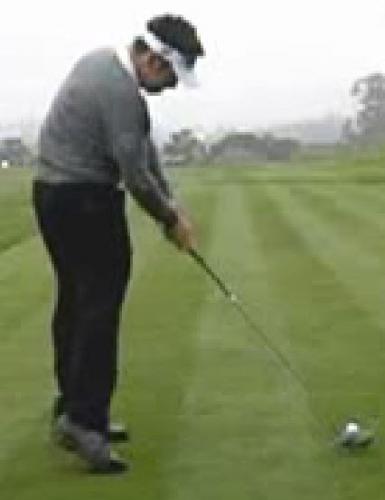
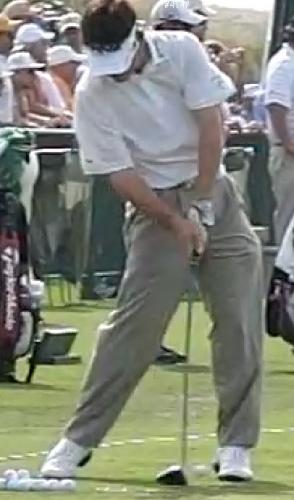
Louis Oosthuizen
Other players in this category are:
Ryan Moore
Aaron Baddeley
Bernhard Langer
Michael Sim
James Driscoll
Chad Collins
Late Lateral Benders
Late lateral benders typically have a bit of an over the top move starting down. But they fire their right arm/elbow move and lateral bend late so they still have good impact positions except that their shoulders may have caught up to their hips more than the gold/silver medalists.
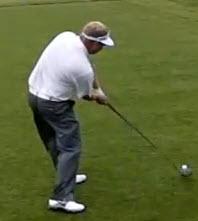
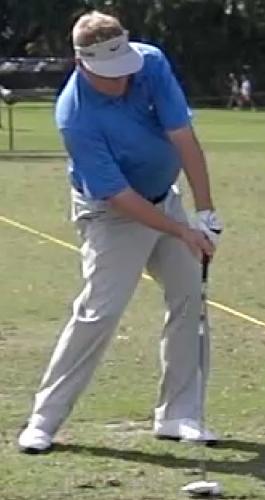
Carl Pettersen

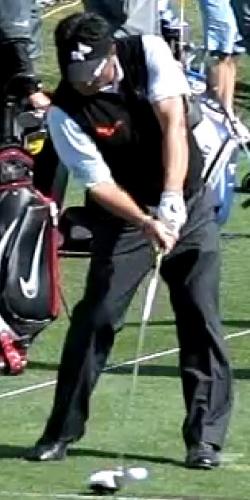
KJ Choi
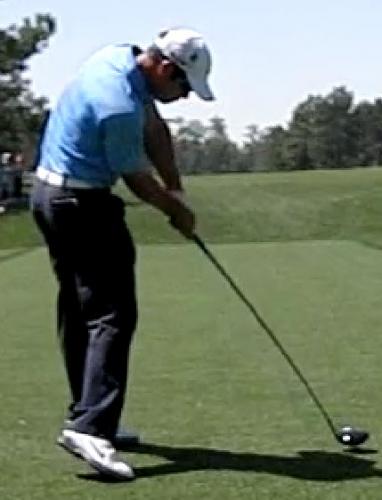
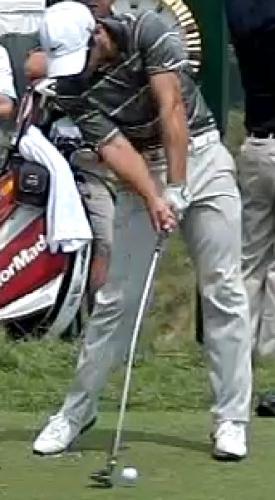
Paul Casey
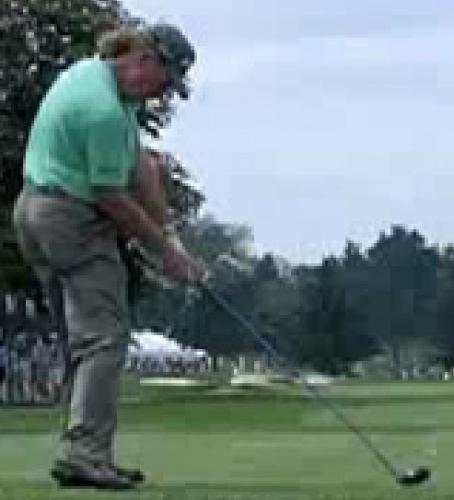
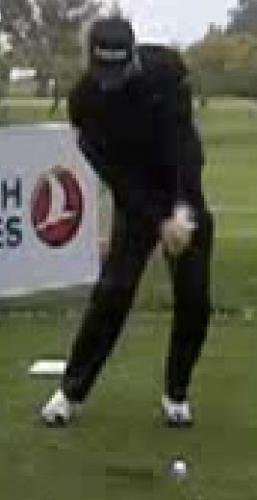
Miguel Angel Jimenez
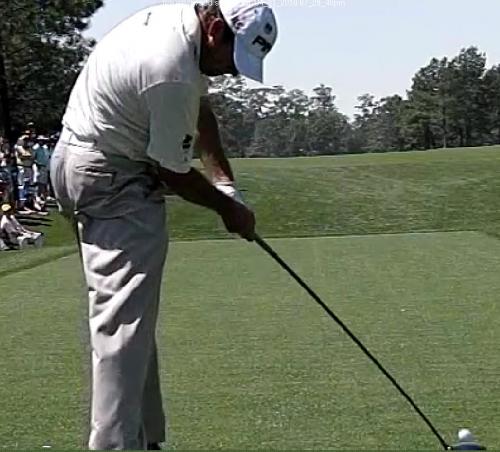

Lee Westwood
This is a very unique swing by Lee. While he loses his lag early and flips it, just before impact he regains lateral bend/lordosis to drive his body through impact. Perhaps, this creates a new category of swing called the “flip’n drive.” This is a very different release pattern than Mark Wilson’s release that allows the club to swing past a stalling body. Chad Campbell does the same below.
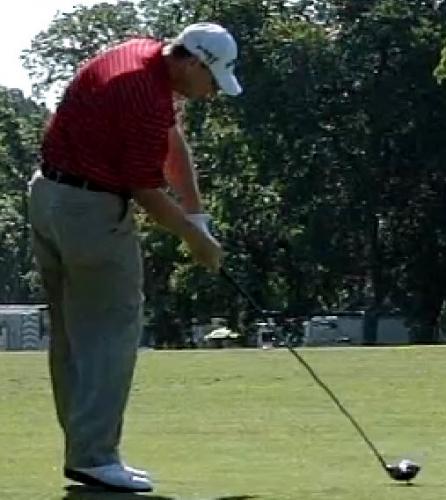
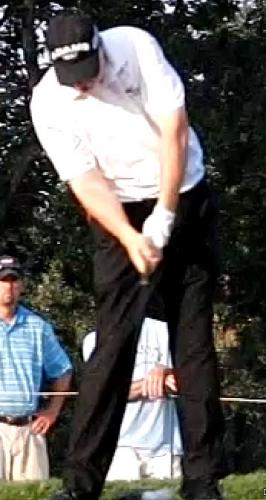
Chad Campbell
Sliding, slight stalling lower body with early release of the shoulders
There are many players in this category and had to be further classified into three subcategories; without right arm straightening, with right arm straightening and with right arm straightening and right wrist releasing.
Group 1: Without right arm straightening
This group is losing their lateral bend just before impact. It triggers right shoulder internal rotation a bit early, and typically a slight disconnect of the spine gears that can drive the upper and lower halves of the body together. But by keeping their right arm bent, they have just a bit more control of their release style.

Rory McIlroy
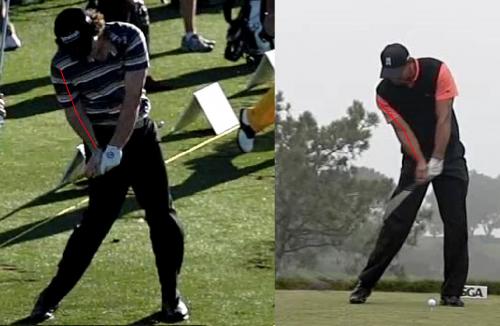
Here you can see early right shoulder internal rotation by Mr. Wozniacki.
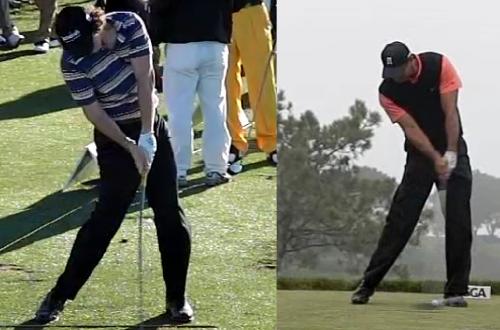
But he saves impact by driving his left arm forward. Most amateurs cannot save it once early right shoulder internal rotation occurs. Typically it will trigger the right arm to straighten and create a flip.
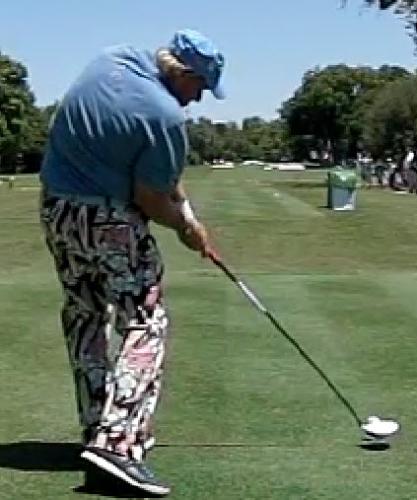

John Daly
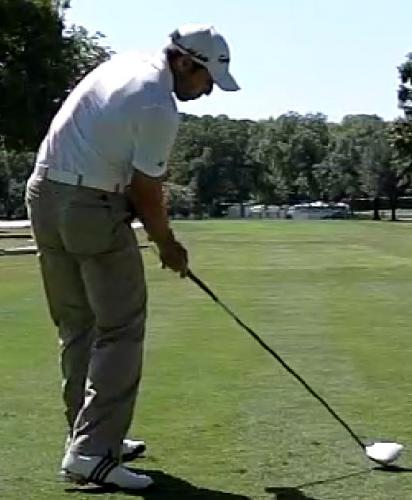

Sergio Garcia
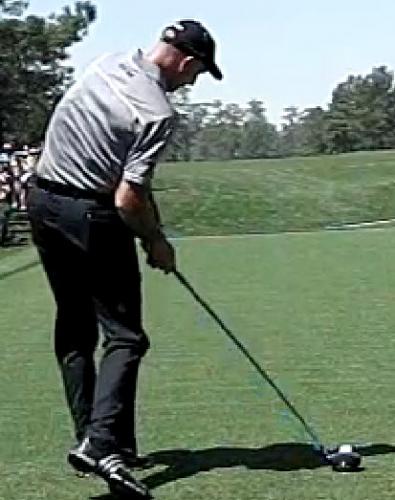
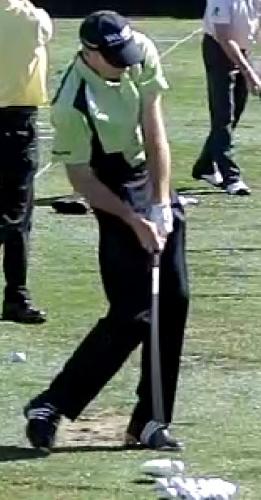
Jim Furyk
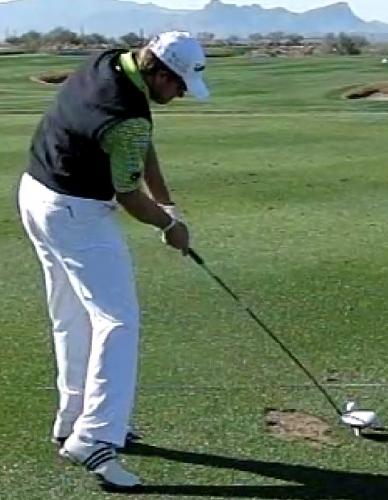
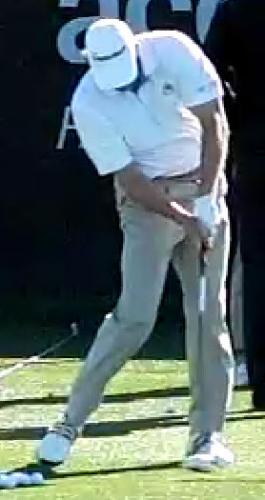
Retief Goosen
Other players in this category are:
Tom Watson
Tom Gillis
Sang Moon Bae
Darren Clarke
Jason Day
Scott Verplank
Robert Allenby
Thomas Bjorn
Lucas Glover
Paul Goydos
Group 2: Sliding/stalling lower body with right arm straightening
The players in this subcategory are all slightly stalling their lower body and this allows their upper body to catch up rotationally. Thus, you see less cleared hips and shoulders slightly open at impact. This triggers right arm firing and with proper arm/hand movements, they avoid flipping. But they still are making compensations with their upper spine extending, pulling the chest away from the ball or sliding farther left in order to make space for extending arms.

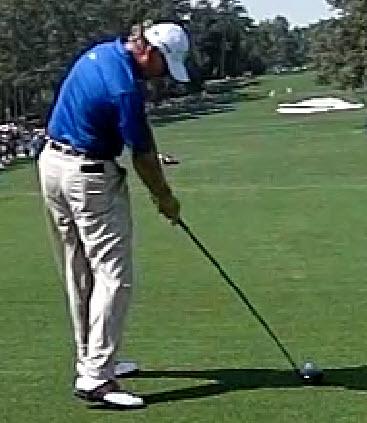
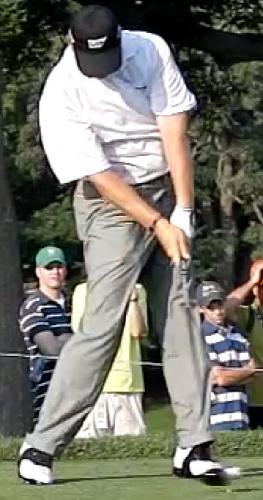
Ernie Els from early 1990’s (left) when he was winning majors was far more dynamic and rotated in the hips and rib cage. Now he has more of a shoulder/arm swing that’s less powerful and interestingly less consistent.
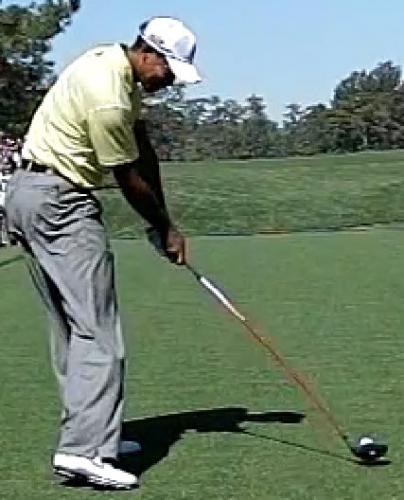
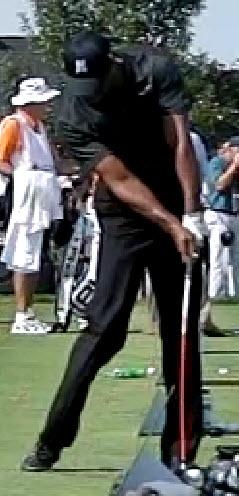
Tiger Woods 2011
Perhaps the effect of sliding farther left? He has less hip and chest rotation than in his prime.
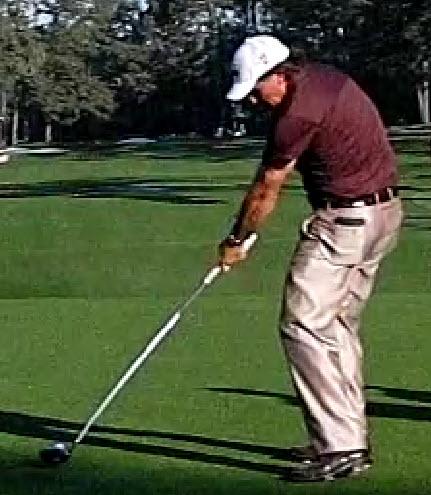
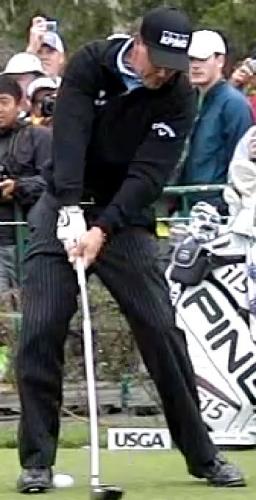
Phil Mickelson
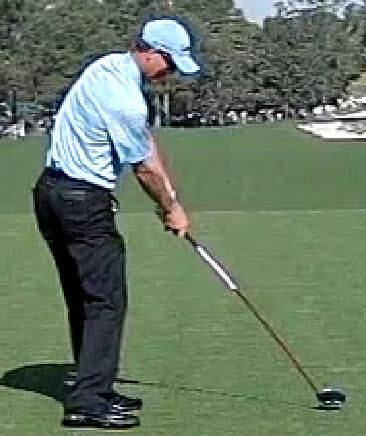
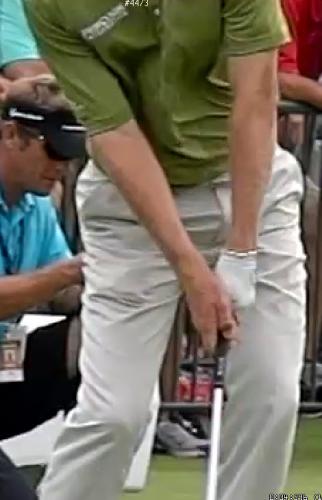
John Senden
Other players in this category are:
Kris Blanks
Charles Howell III
Stewart Cink
Kevin Stadler
Stuart Appleby
Anthony Kim
Justin Leonard
Ryuji Imada
Kent Jones
Nathan Green
No Medals Awarded
Group 3: Sliding/stalling lower body with right arm straightening and right wrist releasing
Another way of saying this is that they have even less dynamic lower body action and rib cage rotation than those in Group 1 or 2. This increases the likelihood of a flip, underflip or flip/roll release occurring. The compensation for that is that the upper body might tend to slide more left to “cover the ball.” This will further reduce the rotation therefore decrease power.


Mark Wilson

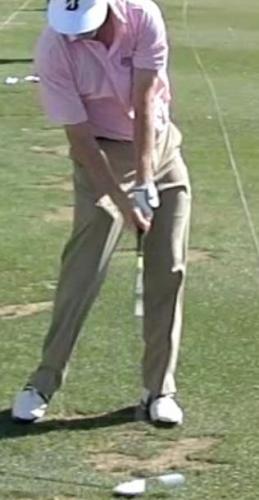
Brandt Snedeker

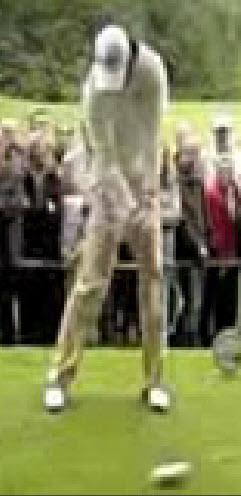
Martin Kaymer
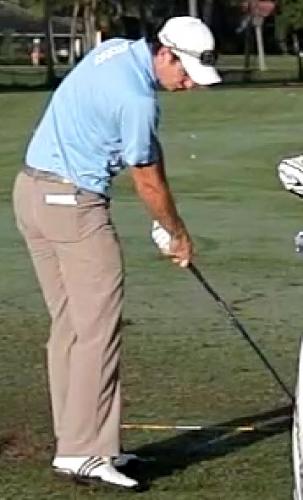
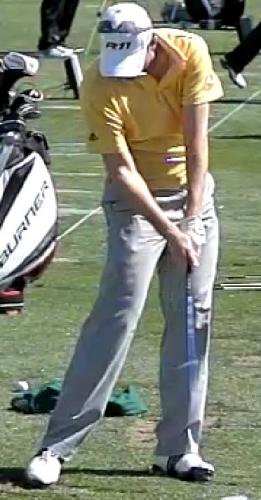
Justin Rose
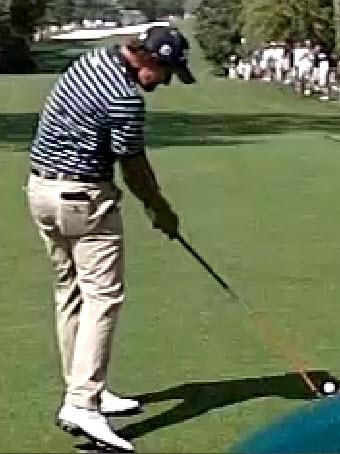
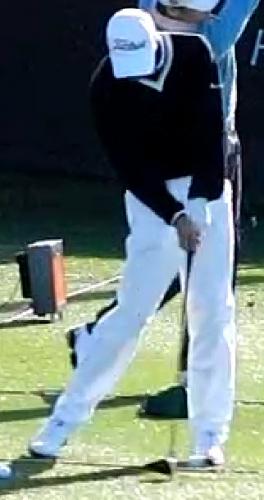
Adam Scott
Butch seems to think Adam swings like a young Tiger. Not! Slight loss of “spine angle,” less hip rotation than Tiger, left leg does not straighten (posted up) and his shoulders are catching up a bit.
Other players with this swing are:
Matteo Manaserro
Oliver Wilson
Hideto Tanihara
Francesco Molinari
YE Yang
Rickie Fowler
Jonas Blixt
Jarrod Lyle
John Rollins
Wen Chong Liang
Hip Sliders
When compared with the elite swings on tour, the sliders lose half the equation that creates great body rotation… lordosis. Thus, sliders/tilters do not rotate the sternum or rib cage area much (hip rotation is limited as well). Also since the lower body slides so far left, they tilt their entire spine away from the target in order to retain balance. It results in a disconnecting of the spine gears therefore the inability to rotate the entire body by the time of impact (they can rotate well after impact but what does that mean?). See how much more rotation Woodland has in his hips and rib cage area as compared to Zach?


There’s also more lateral bend in the thoracic spine in Woodland. Zach’s spine is straighter yet tilted to the right.


This may be difficult for the untrained eye to see but since Zach’s tailbone is sliding toward the target and spine tilting back, the right shoulder is farther away from his right hip than Woodland’s. Woodland on the other hand, has his sacrum or tailbone moving away from the target and this helps him to retain the connection of his spine gears. Therefore Woodland rotates much better and faster.
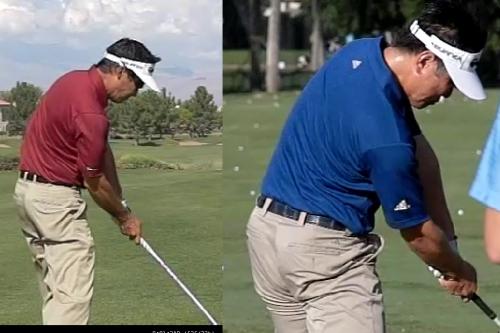
Dean Wilson vs. Charlie Wi
Here’s an interesting comparison between two students of the same swing philosophy. How is it that Charlie’s impact position looks so much better than Dean? Just as Hunter Mahan rotates so much better than the rest of Foley’s stable, is this another case of the “best student is the worst listener syndrome” at work here?
Dean has less tilt to his shoulders, much less lateral bend/lordosis, no glute fire (relaxed butt cheeks) and a lot less rotation of the hips and rib cage/sternum area. The question is, was Charlie taught to move like this by strictly following the S & T method or is he using his own natural athletic instincts (in other words, not listening to the instruction)? My guess is the latter since the continuous slide (and rotate later) is taught as the way to golfing nirvana by the stack and tilt teachers.


Jeff Maggert
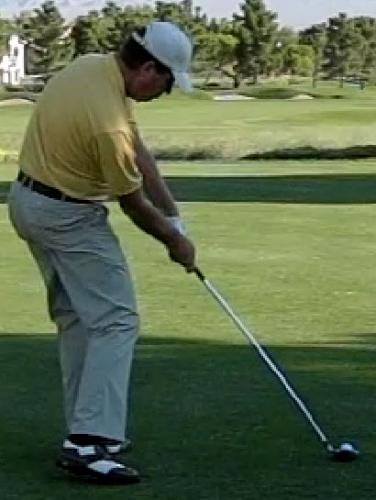

Steve Elkington
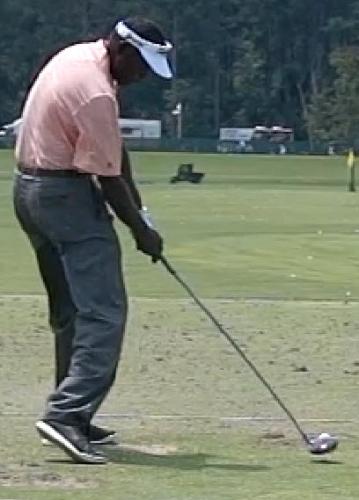
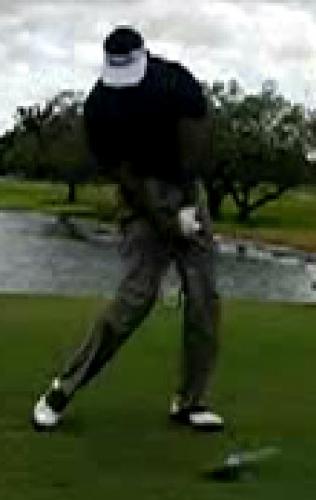
Vijay Singh
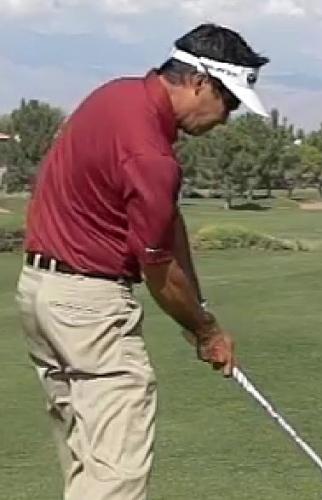
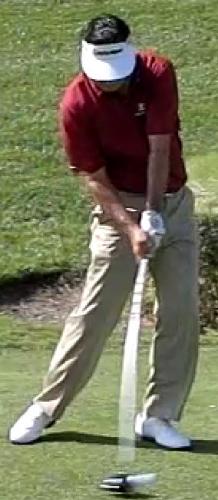
Dean Wilson
Others in this category are:
Alex Cejka
Pat Perez
Ricky Barnes
Kevin Na
Jeff Overton
Robert Karlsson
Geoff Ogilvy
Total body stall
This group can slide, stall, jump, lose spine angle, lose lateral bend and lordosis or any combination. It is hard to avoid flipping it when your body is not supplying the rotational power. Notice the wrist positions of the players in this category.
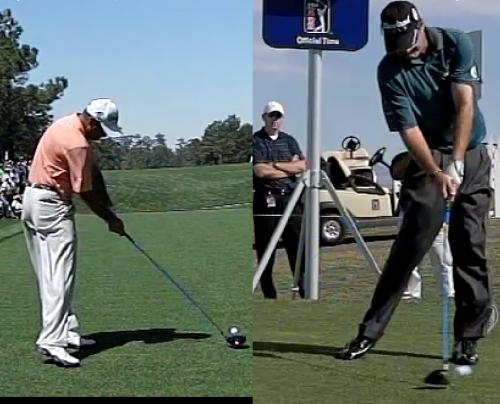
Jerry Kelly

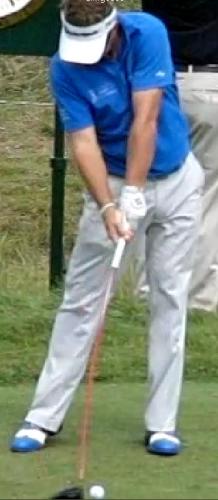
Brian Gay
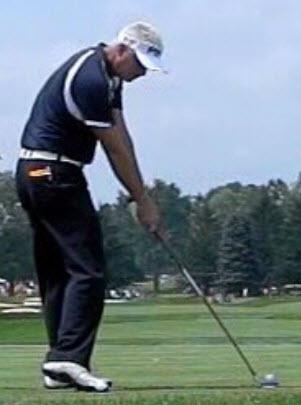
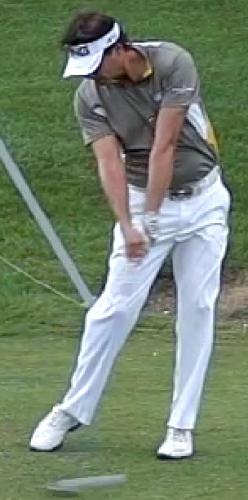
Daniel Chopra
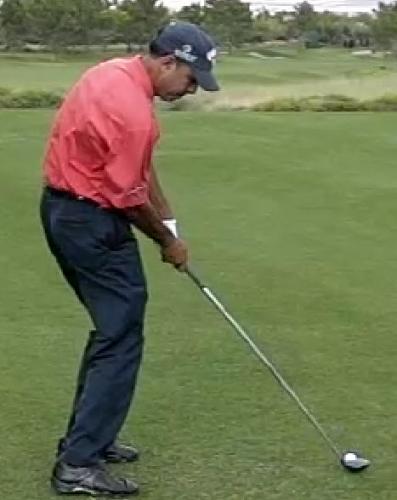
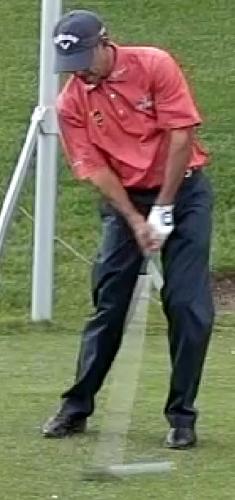
Jeev Milkha Singh
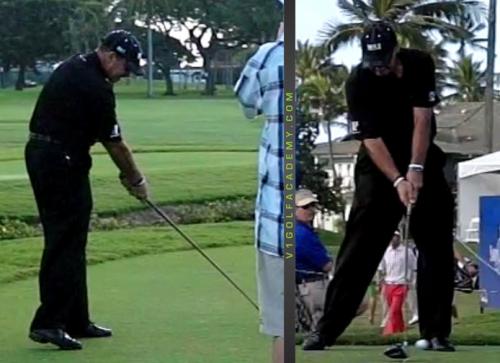
Rocco Mediate
Others in this category are:
Colt Knost
Tim Herron
Shoulders catching up and turning on similar plane as hips
Some people have a view that the shoulders should turn parallel to the hips. This requires release of lateral bend in order to rotate the shoulders. It also means that not so powerful oblique muscles become prime movers in this swing.
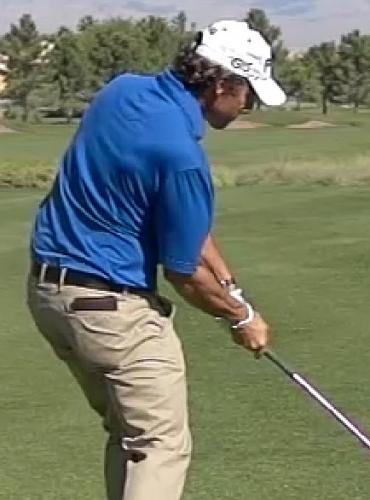
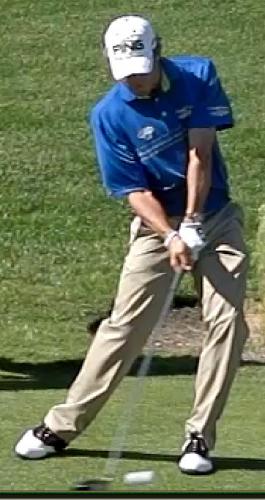
Chris Tidland
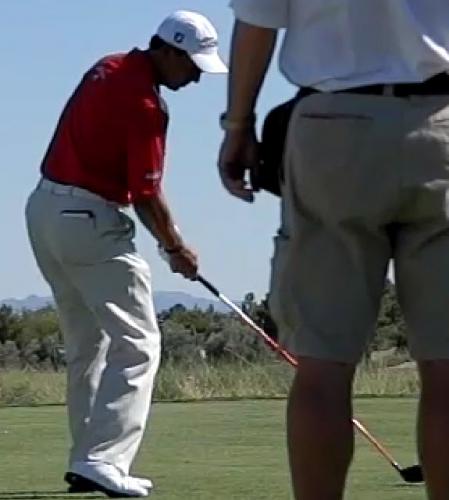

Tom Pernice Jr.
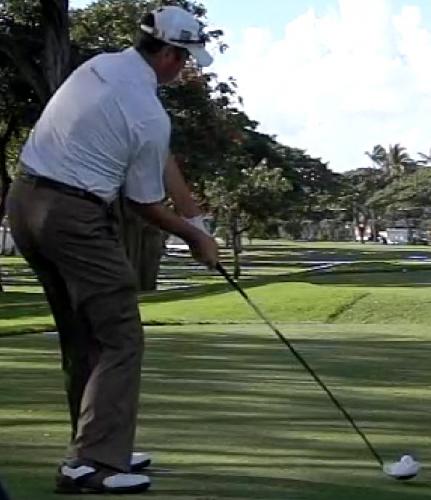
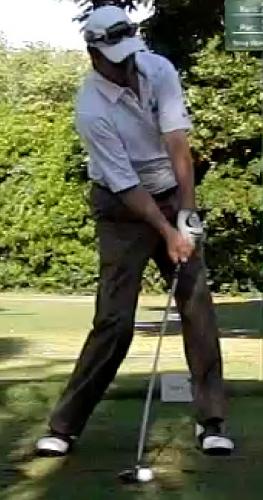
Shane Bertsch
As you can see, there are huge variations in the impact positions from target line view in the tour pros. There are a lot of discussion topics to be covered in future articles but for now, I hope everyone can see that there is a clear trend, the more your lower body and rib cage stalls (or total body stall), for whatever reason hips or chest sliding, stalling or shoulder/arm dominance, loss of lateral bend or lordosis, the greater the probability that your release pattern will turn into a flip, roll or flip/roll increases dramatically. This means you’ll have less power and less control/consistency.
But is that how the elite do it on tour? Is that how Bubba hits short irons into par 5’s? The elite players bomb it and they have learned to or maybe have been forced to learn to be more precice or according to Charles Darwin they would not exist on tour.
In other words, combining maximum power and control in a golf swing is possible. The elite players have found their way to this swing mostly by their own natural athleticism (not instruction). If you want to play your best golf, why can’t you do the same?
The best way to use this study would be to take a video of yourself and screenshot your impact positions (front and target view). Then see how you stack up against the tour players. If anyone wants to see the full study with pictures of all players, I will be posting it up on http://www.jeffygolf.com./.

